Finnish mobile phone maker Nokia has yet another thing to be proud of. While it is the largest handset vendor in the world, now it is also recognized as the most sustainable technology company all around the world, as showed by the 2009 -10 edition of the prestigious Dow Jones Sustainability Indexes published today. Nokia has been rated as the leader in the Europe and Communications categories for a few years now, and has also been chosen as the “World Technology Supersector Leader,” which turns it into the leading sustainable company in the entire global industry.
Commenting on the news, Rick Simonson, executive vice-president and chief financial officer, Nokia, said, “Achieving the world number one slot across the entire global technology industry is a great achievement. It reflects the continued and strong commitment by Nokia employees to sustainable business practices. We remain committed to action in this area because acting responsibly is not only the right thing to do, it is also undoubtedly the best thing for our business.”
The mobile phone maker stated that it had been preoccupied with the environment and it made sustainable activities for more than a decade now. At the same time, it also said that all of its handsets were designed in an environmental conscious way, including their packaging, energy consumption, and the materials used for them, as well as their recycling process. The reduction of energy consumption across all of Nokia's businesses is yet another factor that the company stressed upon. At the same time, Nokia also stated that it planned on using more green electricity than the 25 percent of the total it consumes at the moment.
Other highlights from the company's environmental activities also include the work with public sector bodies, NGOs and voluntary groups to address different environmental, social or economic issues that the mobile technology meets. Such examples would be the development of dedicated mobile software that is being used at the moment for monitoring the outbreak of diseases in Brazil, as well as the use of mobile devices to deliver educational content to children in different areas of Brazil, the Philippines, or South Africa.

 14 DAY TRIAL //
14 DAY TRIAL //